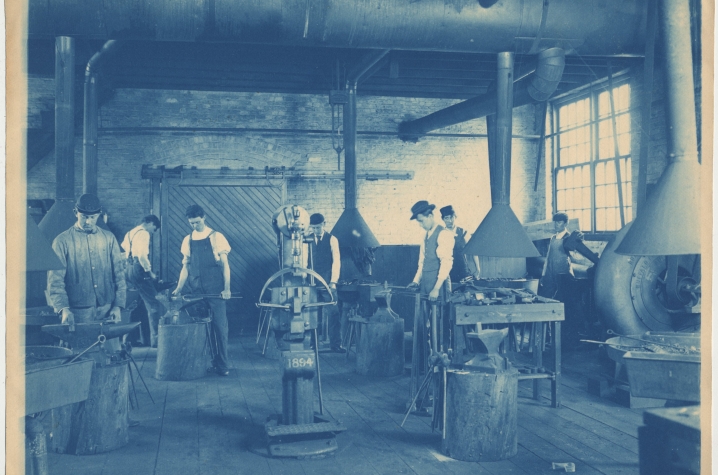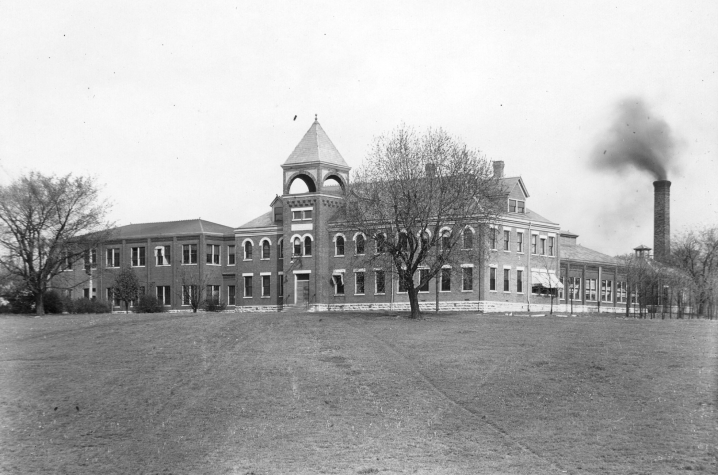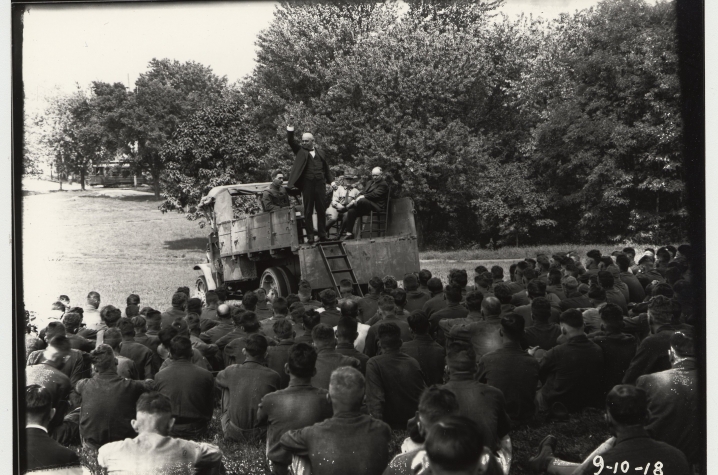UK College of Engineering: Building Upon a Foundation Laid 150 Years Ago
LEXINGTON, Ky. (Jan. 21, 2015) — As construction of state-of-the-art buildings, new partnerships and student enrollment continue to progress and expand, many things have changed at the University of Kentucky in the past few years, let alone the past 150. And while the university continues to make significant strides every day in its unparalleled commitment to education, innovation and the people it serves, the groundwork laid 150 years ago still remains.
With a storied past dating back to Feb. 22, 1865, UK celebrates the resilient foundation it was built upon, and is still building upon today, thanks in part to one college that has been constructing and developing ever since — the College of Engineering.
The College of Engineering was very much a part of the university when it was founded; in fact, one of two parts. The university's mission at its inception was to be a great agricultural and mechanical university for the Mississippi Valley. Following the passage of an act that approved the Morrill Land-Grant College Act provisions in 1865, Kentucky University Regent John Bryan Bowman established the "Agricultural and Mechanical College of Kentucky," or the "A. & M. College."
With a dozen instructors eager to educate around 200 students, the foundation of the university and college, while strong, was small. What we now know as the College of Engineering, the mechanical division of the college, began with a mission to test and manufacture agricultural machinery.
Students studied civil engineering and mining at Henry Clay's estate, "Ashland," where the "Ashland Mechanical Works," was erected in 1868. A machine shop, mechanical shop and paint shop allowed young men to study vocational skills while earning money to pay for their education, a Bachelor of Science degree, but not specifically in engineering.
Ten years later, the A. & M. College began to undergo a momentous transformation, including its move to the old fair grounds on South Limestone in 1882, where the university still stands. With that brought the addition of an engineering course in 1886 that led to the degree of civil engineering (C.E.), and the establishment of the Department of Engineering, led by Dean William Newbrough, followed by Dean Merry L. Pence. In June of 1890, John Wesley Gunn, of Lexington, received his civil engineering degree and was the first person to graduate in engineering from the A. & M. College.
Soon after, 1891 marked another milestone for the college. Purdue graduate F. Paul Anderson joined the faculty first as a mechanical engineering professor, then dean, as he established the College of Mechanical Engineering, one of the most successful and influential departments at the institution.
Later, after the name of A. & M. College was changed to the uncomfortable "State University, Lexington, Kentucky," the Civil Engineering and Physics Building, now Pence Hall, was erected. Eventually, the university's name was changed again to its present title, and the College of Engineering set another precedent: Margaret Ingels, the first female engineering graduate from UK, received her bachelor's in mechanical engineering in 1916.
A trailblazer in opening the profession to women, Ingels was only the second female engineering graduate in the United States, and the first to receive the professional degree of mechanical engineer. After UK, Ingels went on to a successful career in studying air conditioning, and was nationally recognized for her work in the profession as a female. UK honored Ingels with an Honorary Doctor of Law degree in 1957 and selected her as a University of Kentucky Distinguished Alumnus in 1965. The College of Engineering also posthumously inducted her into its Hall of Distinction in 1998, and a residence hall named in honor of her, Ingels Hall, opened in 2005 with specialized programming for female engineering students.
In 1918, three engineering colleges were finally consolidated into one thanks to the efforts of Anderson. He then assumed the role of the first dean of the College of Engineering, and is still honored today for his contributions with a campus staple, the F. Paul Anderson Tower. The tower houses the departments of chemical and materials engineering and electrical and computer engineering, as well as classrooms, Engineering Computing Services and the Robert E. Shaver Engineering Library.
As World War I stretched on, the university recognized the timely need for students to develop military skills alongside their academic curriculum. In 1917, all able-bodied male students were involved in either the ROTC, Naval Training Unit, Enlisted Reserve Corps or the Student Army Training Corps. The College of Engineering was especially significant in this venture as engineering students not only attended drills each day, marched to and from classes, and lived in barracks, but welcomed more than 1,000 soldiers to their college in 1918 to receive engineering training.
During World War II, with James H. Graham as dean, who had served as a colonel in the Corps of Engineers of the American Expeditionary Forces, the college again provided engineering instruction and training to more than 3,000 soldiers. After the war ended, 1,280 students enrolled in the college in 1946, comprising 19 percent of the university’s total student body.
Through the years, the College of Engineering would continue to construct solutions to society's problems, but on a much grander scale, focused on issues that not only affect Kentucky, but the world.
The 1950s brought not only a new dean, Daniel V. Terrell, but new course content, including digital computer and analog computer circuit design, molecular engineering, solid-state electronics and the chemical engineering department. It was also during this time, in 1951, that Holloway Fields Jr., the first African-American student to receive an undergraduate degree from UK graduated with a bachelor’s degree in electrical engineering. Following his graduation, Fields enjoyed an esteemed career with General Electric and was inducted into the College of Engineering’s Hall of Distinction in 1998.
In the following years, under the guidance of Dean Robert E. Shaver, much of the college’s focus was placed on enhancing curriculum, facilities and equipment. F. Paul Anderson Tower replaced Mechanical Hall and formed one central engineering complex, the quadrangle. By 1965, three original engineering departments had expanded to seven, 5,649 students had received a bachelor’s degree, 576 had received a master’s and six students had received a doctoral degree.
From 1966 to 1989, several deans and interim deans, including Robert M. Drake Jr., James E. Funk, Roger Eichhorn, Donald C. Leigh, Ray M. Bowen, and Vincent P. Drnevich, steered the College of Engineering. During this time, the college again began addressing significant issues impacting Kentucky and beyond.
The Kentucky Department of Highways transferred its Division of Research to the college in 1981, later established as the Kentucky Transportation Center (KTC). KTC works to improve the safety, efficiency and sustainability of Kentucky’s transportation system through research and technology transfer. In 1982, the Institute for Mining and Minerals Research (the forerunner to the UK Center for Applied Energy Research) was established with a grant from the Kentucky legislature.
As another Purdue alumnus joined the college as dean, 1990 to 2012 would prove to be a time of advancement for the college, as it adapted to 21st century engineering and education needs. Thomas W. Lester, who had taught mechanical engineering at Kansas State University and Louisiana State University, became dean of the College of Engineering in 1990.
In the mid-1990s, the college diversified its curriculum once again with the addition of the Department of Computer Science, originally part of the College of Arts and Sciences, as well the renaming of the Department of Agricultural Engineering to the Department of Biosystems and Agricultural Engineering, and the Department of Engineering Mechanics consolidation into the Department of Mechanical Engineering.
Today, there are eight departments in the college, including:
- Biomedical Engineering;
- Biosystems and Agricultural Engineering;
- Chemicals and Materials Engineering;
- Civil Engineering;
- Computer Science;
- Electrical and Computer Engineering;
- Mechanical Engineering; and
- Mining Engineering.
In 1995, coming a long way from the college’s first woman and African-American graduates, UK Distance Learning awarded a Master of Engineering degree earned entirely via satellite to Eric Bauer of Pittsburgh, Pennsylvania. But this wasn’t the only example of the college expanding its offerings during Dean Lester’s tenure.
Over the next 22 years, Lester, the college’s longest-tenured dean, had a substantial impact on the college, its infrastructure and support to students.
Under his leadership, the Advanced Science and Technology Commercialization Center (ASTeCC), Oliver H. Raymond Building, James F. Hardymon Building, Ralph G. Anderson Building and the Davis Marksbury Building were erected on campus. Lester also oversaw the establishment of the UK College of Engineering Extended Campus Program in Paducah, which allows students to complete a four-year mechanical or chemical engineering degree exclusively in Paducah, Kentucky. The dean also established a scholarship program, later named in his honor as the Thomas W. Lester Scholarship Program, which offers automatic scholarships to students who meet the college’s demanding criteria.
In 2012, Dean Lester stepped down as dean and returned to the mechanical engineering faculty on a full-time basis, and John Y. Walz, former professor and department head of chemical engineering at Virginia Polytechnic and State University, was named the College of Engineering’s 10th dean. Since 2012, Dean Walz has steered the college well on its way to becoming a top 50 college of engineering by 2020.
Growing each year, the college continues to attract the brightest students and is currently at its largest enrollment in the college’s history: 800 students in the Fall 2014 first year class were engineering majors, and more than 3,100 students are enrolled in the college this year. Dean Walz is focusing not only on opening the doors of engineering and its potential to a larger number of students, but doing so in the most effective ways. Expanding the Engineering Residential College, the oldest living learning program on campus that creates an engineering student community outside the classroom, is one example. The residential college went from 100 to 400 students this year and moved into the new Champions Court I residence hall.
Focused on building a robust future, the college still sustains its tradition of delivering solutions to the world’s most pertinent problems. As energy, security, aerospace, biotechnology and more take precedence on the global stage and in Kentucky, engineers play a key role in the grand challenges of our lifetime. And since its inception, the UK College of Engineering has graduated more than 22,000 individuals with the tools to make a difference.
Citing three critical challenges facing the world in the next 50 years — producing energy, water and food — Walz said recently in a UK at the Half interview, “I tell our students, as engineers, we’ll play leading roles in solving each of those problems. These opportunities are available to our students. The world needs you now more than ever before.”
MEDIA CONTACT: Whitney Harder, 859-323-2396, whitney.harder@uky.edu









